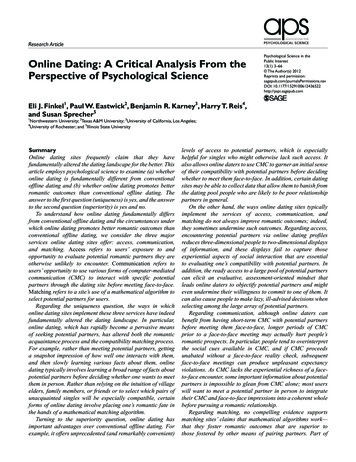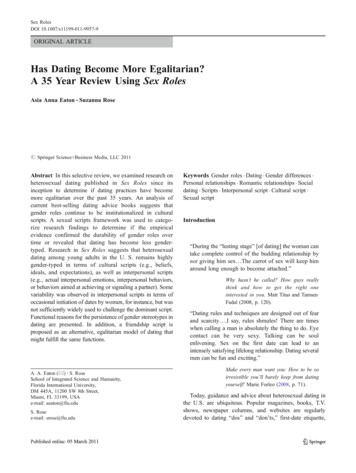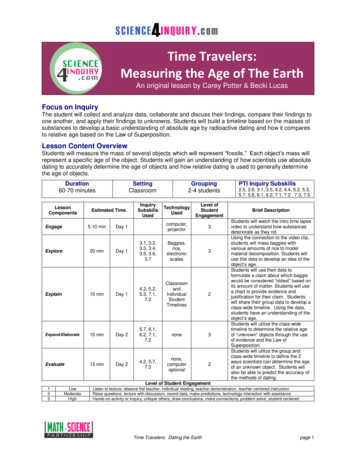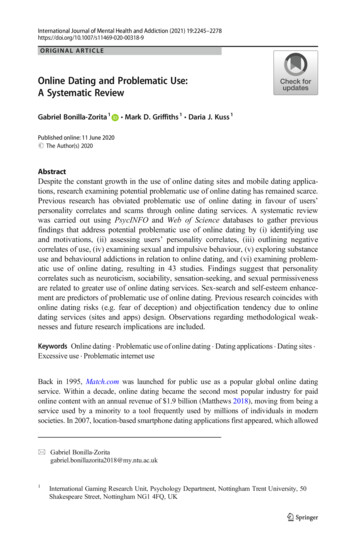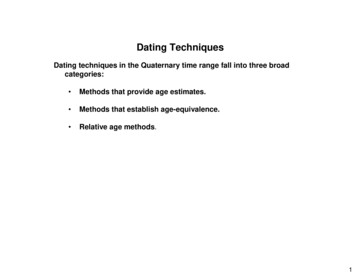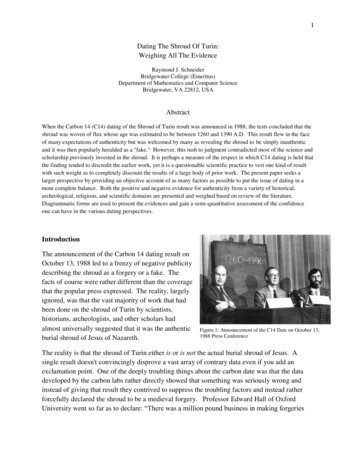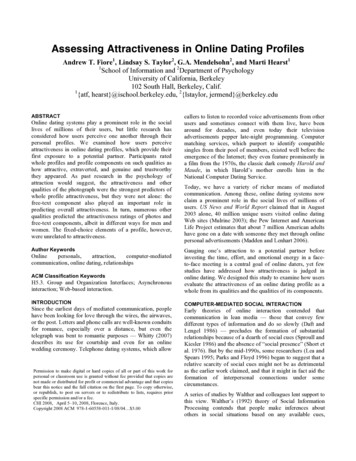
Transcription
Assessing Attractiveness in Online Dating ProfilesAndrew T. Fiore1, Lindsay S. Taylor2, G.A. Mendelsohn2, and Marti Hearst11School of Information and 2Department of PsychologyUniversity of California, Berkeley102 South Hall, Berkeley, Calif.1{atf, hearst}@ischool.berkeley.edu, 2{lstaylor, jermend}@berkeley.eduABSTRACTOnline dating systems play a prominent role in the sociallives of millions of their users, but little research hasconsidered how users perceive one another through theirpersonal profiles. We examined how users perceiveattractiveness in online dating profiles, which provide theirfirst exposure to a potential partner. Participants ratedwhole profiles and profile components on such qualities ashow attractive, extraverted, and genuine and trustworthythey appeared. As past research in the psychology ofattraction would suggest, the attractiveness and otherqualities of the photograph were the strongest predictors ofwhole profile attractiveness, but they were not alone: thefree-text component also played an important role inpredicting overall attractiveness. In turn, numerous otherqualities predicted the attractiveness ratings of photos andfree-text components, albeit in different ways for men andwomen. The fixed-choice elements of a profile, however,were unrelated to attractiveness.Author Keywordscallers to listen to recorded voice advertisements from otherusers and sometimes connect with them live, have beenaround for decades, and even today their televisionadvertisements pepper late-night programming. Computermatching services, which purport to identify compatiblesingles from their pool of members, existed well before theemergence of the Internet; they even feature prominently ina film from the 1970s, the classic dark comedy Harold andMaude, in which Harold’s mother enrolls him in theNational Computer Dating Service.Today, we have a variety of richer means of mediatedcommunication. Among these, online dating systems nowclaim a prominent role in the social lives of millions ofusers. US News and World Report claimed that in August2003 alone, 40 million unique users visited online datingWeb sites (Mulrine 2003); the Pew Internet and AmericanLife Project estimates that about 7 million American adultshave gone on a date with someone they met through onlinepersonal advertisements (Madden and Lenhart 2006).H5.3. Group and Organization Interfaces; Asynchronousinteraction; Web-based interaction.Gauging one’s attraction to a potential partner beforeinvesting the time, effort, and emotional energy in a faceto-face meeting is a central goal of online daters, yet fewstudies have addressed how attractiveness is judged inonline dating. We designed this study to examine how usersevaluate the attractiveness of an online dating profile as awhole from its qualities and the qualities of its components.INTRODUCTIONCOMPUTER-MEDIATED SOCIAL iatedcommunication, online dating, relationshipsACM Classification KeywordsSince the earliest days of mediated communication, peoplehave been looking for love through the wires, the airwaves,or the post. Letters and phone calls are well-known conduitsfor romance, especially over a distance, but even thetelegraph was bent to romantic purposes — Whitty (2007)describes its use for courtship and even for an onlinewedding ceremony. Telephone dating systems, which allowPermission to make digital or hard copies of all or part of this work forpersonal or classroom use is granted without fee provided that copies arenot made or distributed for profit or commercial advantage and that copiesbear this notice and the full citation on the first page. To copy otherwise,or republish, to post on servers or to redistribute to lists, requires priorspecific permission and/or a fee.CHI 2008, April 5–10, 2008, Florence, Italy.Copyright 2008 ACM 978-1-60558-011-1/08/04 5.00Early theories of online interaction contended thatcommunication in lean media — those that convey fewdifferent types of information and do so slowly (Daft andLengel 1986) — precludes the formation of substantialrelationships because of a dearth of social cues (Sproull andKiesler 1986) and the absence of “social presence” (Short etal. 1976). But by the mid-1990s, some researchers (Lea andSpears 1995; Parks and Floyd 1996) began to suggest that arelative scarcity of social cues might not be as detrimentalas the earlier work claimed, and that it might in fact aid theformation of interpersonal connections under somecircumstances.A series of studies by Walther and colleagues lent support tothis view. Walther’s (1992) theory of Social InformationProcessing contends that people make inferences aboutothers in social situations based on any available cues,
however scant. His notion of “hyperpersonal” interaction(Walther 1996; Walther et al. 2001) goes a step farther — itsuggests that people communicating in lean media, wherecues from others are limited in scope and perhaps slow toarrive, might form even higher levels of affinity for oneanother than they would face-to-face. This results, Waltherargues, from a tendency to fill in the blanks optimisticallywhen faced with limited information about a person. Otherstudies also show evidence of greater affinity in cueconstrained contexts. McKenna and colleagues (2002) foundthat pairs of college students in a laboratory study liked eachother better when they met in synchronous, text-only chatthan when they met face-to-face. Online gamers ratingpotential opponents in Riegelsberger et al.’s (2006) studyfound text-only profiles more appealing than photo profiles,which garnered a greater number of highly negativeresponses. The researchers suggest that photo profilesallowed users better to “filter out” undesirable opponents.Self-presentation and Interpersonal PerceptionGoffman (1957) describes the process of self-presentationas a kind of performance. He distinguishes between thecues we “give” intentionally, as part of the deliberateperformance, and those we “give off” unintentionally.Building on these notions and the concept of signaling frombiology, Donath (1998; forthcoming) portrays the onlineperformance of self as a series of signals we attempt to givein order to convey a particular impression to others.Everything from the user name (or “handle”) to the use oflanguage or the choice of a photograph can signal certainqualities in online interaction; some signals “give” intendedmeaning while simultaneously “giving off” additionalunintended information.Face-to-face interaction is a rich medium — that is, itprovides multiple channels of communication (e.g., words,tone of voice, facial expression, gesture) and immediatefeedback (Daft and Lengel 1986). In a face-to-face context,in addition to information conveyed intentionally, cuesgiven off by accident, perhaps through body language, afleeting expression, or an unbidden change in intonation,also provide a great deal of information about other people.Online, however, cues are considerably more limited, andusers have more control over the information they convey.Despite the paucity of cues, personal qualities are stillconveyed in online environments. Gosling and colleagues(2007) found that observers’ ratings of personality traitsbased on Facebook profiles1 correlated (average r 0.23)with self-reports and friends’ reports of the personalitytraits of the profile owners. The correlation was strongestfor extraversion (r 0.46).1Facebook, a social networking Web site, has personalprofiles that share many features with online dating profilesbut differ in that they are not intended for romanticpurposes, and they feature “friends” with whom the userhas indicated a social relationship.ATTRACTIVENESS IN ONLINE DATING PROFILESAlthough online dating users are limited in the types of cuesavailable for self-presentation, they are able to spend timecreating and revising their profiles in order to put their bestfoot forward. That is, they are able to tailor their selfpresentations online in ways they cannot face-to-face.Users writing their profiles have competing motivations —first, to present themselves as attractively as possible, inorder to draw the attention of potential dates, and second, topresent themselves accurately, so that people who areattracted to them online will still find them attractive whenthey eventually meet. Fiore and Donath (2004) suggest thatonline dating users might consider a certain amount ofexaggeration necessary if they perceive, as per the popularconception, that everyone else is exaggerating — then theymust exaggerate as well just to maintain equal footing withcompetitors. Indeed, Hancock and colleagues (2007) foundthat small exaggerations about height, weight, and age inonline dating profiles were common.Since users can self-present selectively (or aspirationallyor deceptively) in their online dating profiles, it is difficultfor viewers of the profile to be certain that they have anaccurate picture of what another user is like in person. Ifthe purpose of online dating were to find partners withwhom to interact online only, this would pose no problem— the online relationship would be the end goal. Butwhen the goal is to commence a face-to-face relationship,it can be difficult to discern whom one will find attractivein person.Assessing AttractivenessHistorically, theories of interpersonal attraction andinterpersonal judgments have emphasized the importance ofphysical attributes over other factors such as personalityand intelligence (e.g., Dion et al. 1972; Walster et al. 1966).Accordingly, online dating sites often urge their users topost photos of themselves to increase the chances thatpotential dates will contact them. Indeed, 85% ofinterviewees in a study of Australian online dating userssaid they would not contact someone without a photo on hisor her profile (Whitty and Carr 2006). Thus, it is possiblethat the attractiveness of one’s photo is the sole, or at leastthe strongest, predictor of the appeal of one’s online datingprofile as a whole. At the same time, however, the bulk ofthe typical site’s profile is devoted to describing one’spersonal characteristics and one’s ideal match, althoughresearch has not demonstrated that this informationcontributes to one’s attractiveness to potential partners.Only a few studies so far have considered how users judgeattractiveness online generally or in online dating inparticular. Ellison and colleagues (2006) describe thestrategies employed by online dating users to interpret theself-presentations of others. Primarily, the participants theyinterviewed made substantial inferences from small cues,lending support to Walther’s (1992) theory of SocialInformation Processing. For example, one woman felt that
people who were sitting down in their online dating profilephotos were trying to disguise that they were overweight.Perhaps needless to say, in her own photo, she was standing(Ellison et al. 2006).Norton, Frost, and Ariely (2007) found that even thoughonline dating users believe they will like people better whenthey have more information about them, in fact moreinformation leads to less liking, perhaps because it helps usbetter to assess incompatibility. But when we’re presentedwith a highly compatible person, more information allowsus to be more certain that we will like him or her. Thus, anonline dating profile with a lot of information might attractfewer — but potentially more compatible — suitors.Fiore and Donath (2005) used the number of messagesonline daters received as a measure of attractiveness andfound that men received more messages when they wereolder, more educated, and had higher levels of self-reportedattractiveness (which might be something more like selfesteem). Women received more messages when they didnot describe themselves as “heavy,” had higher levels ofself-reported attractiveness, and posted a photo on theirprofiles. These results roughly correspond to what wewould expect from past social psychological research.Although this latter study comes closest, none of theaforementioned studies speaks directly to our researchquestion: What qualities of online dating profiles and theircomponents predict attractiveness?ONLINE DATING SYSTEMSBroadly speaking, Web-based online dating systemsinclude the following (Fiore and Donath 2004): Personal profiles for each user, which includedemographic and other fixed-choice responses, freetext responses to prompts, and, optionally, one or morephotographs. Searching and/or matching mechanisms so that userscan find potential dates from among the thousands ofprofiles on a typical system. Some means of private communication that permitsusers to contact potential dates within the closed onlinedating system without disclosing an email address,phone number, or identifying information. This usuallymeans a private mail system, but it sometimes alsoincludes instant messaging or the ability to send“winks” or some other contentless token of interest. Optionally, other forms of self-description: forexample, the results of a personality test, or audio andvideo clips uploaded by the user.METHODIn this study, we selected 50 online dating profiles from theYahoo! Personals Web site, comprising five men and fivewomen between 20 and 30 years of age from each of fiveU.S. cities — Atlanta, Boston, San Diego, Seattle, and St.Louis — chosen to represent different regions of thecountry. To gather five profiles of each gender in each city,we searched for profiles with photos meeting theappropriate criteria — e.g., women in Seattle — andrandomly chose one profile from the 10 displayed on eachof the first five pages of the search results. The searchresults were approximately but not strictly ordered byrecency of activity, so the profiles we captured belonged tousers who had logged in recently.As described above, these profiles consist of severalcomponents. First, the fixed-choice portion contains a seriesof multiple-choice questions with pre-set responses,including demographics, such as age, gender, race, andreligion, and preferences, such as smoking and drinkinghabits, favorite activities, and interests. Not all profilesincluded responses to every fixed-choice item. Next, thefree-text section allows users to describe themselves and thepartner they seek in their own words; these sections rangefrom a few words to many paragraphs. Finally, each profileincludes a photo uploaded by the profile’s author. Someprofiles had more than one photo; in these cases we usedonly the primary one. Yahoo! Personals crops the primaryphotos, so all were headshots.We saved images of these profiles exactly as they appearedin the Web browser and then subdivided them with AdobePhotoshop into these three components: the free-text part ofthe profile, the primary photo, and the fixed-choice part ofthe profile (Figure 1). With 50 profiles, this process yieldeda total of 200 images, including images of whole profiles.Using a custom-built Web application that identifiedparticipants only by an anonymous number, we askedparticipants their own sex and the sex of the people theyusually date. Our software then presented each participantwith a randomly selected series of profile components (freetext, fixed choice, and photo) and whole profiles drawnfrom the 25 profiles of the appropriate gender. With fourimages generated from each profile, each participant couldrate up to 100 images.The software (Figure 2) asked participants to rate wholeprofiles and profile components using a five-point Likerttype scale from 0 (not at all) to 4 (very much) on thefollowing dimensions: AttractiveGenuine, trustworthyMasculineFeminineWarm, kindSelf-esteemExtravertedSelf-centeredThe order of these dimensions was randomized with eachprofile or profile component for each participant so as toavoid order effects. Participants always had the option to
PhotoFixedFixed choicechoiceFixed choiceFigure 1. (Left and above) One of the 50 online datingprofiles, obfuscated to protect the privacy of the profile author.The entire figure represents the whole profile; the threeconstituent pieces are highlighted. The fixed-choice piece isstitched together from the noncontiguous parts with Photoshop.(The profile appears online and in our study software as onelong Web page, but it is broken up here to fit on the page.)Free textFixed choiceFigure 2. (Above) The Web interface participants used to rateprofiles and profile pieces. Radio buttons capture theparticipant’s ratings and confidence levels. The profile orprofile component to be rated appears to the right on screen.
choose “Prefer not to answer” for any of the dimensions.For each dimension for which they did provide a rating, thesoftware prompted participants to indicate how confidentthey were about their response using a three-point Likerttype scale where 1 denoted low confidence in their ratingand 3 denoted high confidence. We included the confidenceratings so that we could distinguish between certain anduncertain ratings and so users would feel comfortablegiving ratings when they were uncertain instead of choosing“Prefer not to answer.”At the start of the session, the software presented eachparticipant with one image (whole profile, photo, free text,or fixed choice) from each of the 25 profiles, with both theorder of the profiles and the choice among the four types ofimage randomized on the fly for each participant. If theparticipant completed ratings of these first 25 profiles andprofile components, which most did, the software thenbegan to show them randomly ordered new images fromprofiles from which they had already seen an image. Eventhough most participants rated more than one image fromeach profile, they never rated the exact same component orwhole profile more than once. We marked those ratings ofimages from profiles from which the participant hadpreviously rated another image so that we could analyzethem separately, in case previous exposure to another imageof the same profile tainted the ratings of a later image.Participants rated as many whole profiles and profilecomponents as they could in the 50-minute period. If theyrated all 100 available to them, the software ended theirsession early to ensure that no whole profile or componentwas rated more than once. At the end of the period,participants provided demographic information and ratingsof their own attractiveness and self-esteem on a 0 to 4 scale,and they were debriefed.ParticipantsWe recruited participants from a pool consisting ofmembers of the university community, primarily studentsand staff, who were paid for their participation. Our sampleconsisted of 65 heterosexual participants, including 41women (63%), 23 men (35%), and one who preferred not togive a gender (2%). The participants were between 19 and25 years old, with a mean and median age of 21. Themajority (66%) were Asian, and 20% were white. Theremaining participants were of various ethnicities ordeclined to state an ethnicity. The participants’ mean selfreported attractiveness was 2.8 (median 3) on a 0 to 4 scale;their mean self-reported self-esteem was 2.7 (median 3) onthe same scale.ProfilesThe mean age of the people in our set of 50 online datingprofiles was 25.7 years (median 26). Half were men andhalf were women. Most were Caucasian (56%); the restwere African-American (16%), Asian (4%), East Indian(2%), Hispanic/Latino (10%), Middle Eastern (2%), PacificIslander (4%), or another ethnicity (2%). Two profiles didnot report an ethnicity.The free-text components of the profiles ranged from 29 to793 words long (mean 168; median 114). Analysis withthe Linguistic Inquiry and Word Count software(Pennebaker and Francis 1996) showed that profile authorsused more positive emotion words (7.5% of the words inthe free-text component on average) than negative emotionwords (0.9% on average), t (60.4) 12.8, p .001. Womenused significantly more positive emotion words than men(8.6% vs. 6.3% of words; t (40.8) 2.42, p .05) and moreself-references such as “I,” “me,” and “my” (9.5% vs.7.5%; t (45.7) 2.34, p .05).RESULTSEach whole profile and profile component was rated bymultiple participants on each of the eight dimensions, for atotal of 29,120 ratings. A preliminary analysis showed thatsome ratings of Profile 33 were outliers; upon investigation,we found that the woman in this profile mentioned that shewas transsexual, though this was evident only in her freetext response, not in her photo or fixed-choice response. Weexcluded responses to Profile 33 and its components fromfurther analysis. The perception of transsexual individualsonline is worthy of exploration, but having just onerepresentative in this set of profiles was insufficient foranalysis.Standardization of the responsesIn rating profiles and profile components, participantsmight reasonably differ in how they interpret and use the 0to 4 scale. For example, Participant A might assign only 3sand 4s, so even though 3 is a moderately high rating on thescale, for Participant A it is low. On the other hand,Participant B might assign no 3s or 4s and many 1s and 2s,so for this participant, 2 would be a high rating. The sameparticipant’s interpretation of the scale might even differfrom one dimension to another. Since the qualities we arestudying are subjective, we are primarily interested in therelative magnitude of a rating. That is, we want to knowwhich ratings are high and low for a given participant, for agiven quality even if they are not high or low on the scale inabsolute terms.To achieve this, we employed a type of standardizationcalled “ipsatization” (Cunningham 1977). First, wecalculated the mean and standard deviation of the ratingsfor each dimension for each participant — that is, wecalculated 8 dimensions 65 participants 520 means andSDs. Then we standardized each rating by subtracting themean and dividing by the SD associated with theappropriate participant and dimension. For example, wefound Participant A’s mean rating and its standard deviationon the extraversion dimension, then standardized all of A’sextraversion ratings with those values. All analyses wereperformed with these ipsatized ratings.
dimensions) distilled from more than 29,000 raw responses.In the following sections, we report standardized estimatesof the OLS regression coefficients with associated tstatistics and p values.Repetition EffectsWe were uncertain whether participants’ ratings of a profilecomponent or whole profile would differ if they hadpreviously rated another component (or the whole) of thesame profile. (Note that although participants did ratemultiple components from each profile, they never rated theexact same image more than once.) After data collectionwas complete, we checked whether those components ratedafter a participant had already seen other components fromthe same profile were rated differently from components ofprofiles the participant had never seen before. Analysesindicated that they did not differ meaningfully, so for therest of our analyses, we used the complete set of ratings.Predicting attractiveness of whole profilesWe begin our analysis by considering the associationbetween whole-profile attractiveness and the other sevendimensions on which whole profiles were rated. Then weexamine how the attractiveness and other qualities ofprofile components predict the attractiveness of wholeprofiles.Attractiveness and other qualities of whole profilesFor men’s whole profiles (Table 1, column 1), highmasculinity ratings predicted high overall attractiveness (b .42, t (18) 2.40, p .05). None of the other qualities ofwhole profiles was a significant predictor of attractiveness.Regression models to predict attractivenessWe built ordinary least squares regression models to do thefollowing:1.Predict the attractiveness of whole profiles fromratings of the other seven dimensions of wholeprofiles.2.Predict the attractiveness of whole profiles fromthe attractiveness and other qualities of theircomponents (free text, fixed choice, and photo).3.Predict the attractiveness of the profilecomponents from their ratings on the other sevendimensions.For women’s whole profiles (Table 1, column 2), highextraversion ratings predicted high overall attractiveness (b .73, t (17) 4.01, p .001). Low masculinity scores wereassociated with higher attractiveness, but this result was ofborderline significance (b –.31, t (17) 2.09, p .06).Whole-profile attractiveness and component attractivenessNext, we examined the association between whole-profileattractiveness and the attractiveness of the profilecomponents (Table 2). For both men’s and women’sprofiles, photo attractiveness was by far the strongest andmost significant predictor of whole-profile attractiveness, b .87, t (21) 8.46, p .001 for women’s profiles and b .72, t (22) 6.77, p .001 for men’s profiles. Theattractiveness of the free-text components was also asignificant predictor of whole-profile attractiveness forwomen’s profiles (b .22, t (21) 2.14, p .05) and aBecause not every participant rated each component of eachprofile, we averaged responses across participants to findthe mean ratings of each whole profile and each componentfor each of the eight dimensions. We consider these to bepoint estimates of the true score of each profile or profilecomponent on each of the eight dimensions. Thus, theseregression models are based on various combinations ofthese 1600 mean ratings (50 profiles 4 images 8 ratingWhole-profile eMENWOMEN.38 (.32).08 (.10).42 (.17) *–.31 (.15) Photo attractivenessMENWOMEN1.62 (.35) ***.15 (.25).24 (.20)Feminine.22 (.18).28 (.17)Warm/kind.16 (.31)–.05 (.16)–1.27 (.39) **Self-esteem.25 (.22)–.16 (.17)–.20 (.27)Extraverted–.10 (.21)Self-centeredAdjusted R2.46 (.18) *.73 (.18) ***.70 (.26) *.19 (.20)–.01 (.16)–.04 (.20).75.83.76*** p .001** p .01* p .05Free-text attractivenessMEN.70 (.15) ***–.49 (.13) **.34 (.17) –.51 (.30).51 (.19) *.07 (.16)–.43 (.23).74 WOMEN.06 (.30).37 (.14) *.30 (.36).29 (.14)–.30 (.24).13 (.34)–.05 (.18).15 (.30).57 (.23) * .19 (.33) –.09 (.15).86.23 (.23)–.11 (.38).07p .1Table 1. Standardized regression models to predict attractiveness ratings of whole profiles, photo components, and free-textcomponents from ratings of these entities on the other seven dimensions. Coefficient estimates with standard errors in parentheses.
Menʼswhole-profileattractivenessCovariatePhoto attr.72 (.11) ***Free-text attr.23 (.13)Fixed-choice attr.09 (.11)Adjusted R2*** p .001Womenʼswhole-profileattractiveness.87 (.10) *** .22 (.10) *–.05 (.10).82** p .01.77* p .05 p .1Table 2. Standardized regression models to predict wholeprofile attractiveness ratings from the attractiveness ratings ofthe profiles’ components. We report coefficient estimates withstandard errors in parentheses.marginally significant predictor for men’s profiles (b .23,t (22) 1.83, p .09). The attractiveness of fixed-choicecomponents was not significantly associated with theattractiveness of whole profiles for men or women.We also built regression models to predict the attractivenessof men’s and women’s profiles with the predictors aboveplus the interaction terms photo free-text, photo fixedchoice, free-text fixed-choice, and the three-wayinteraction photo free-text fixed-response. In thesemodels, for men’s and women’s profiles, main effects ofphoto and free-text attractiveness remained significant,confirming the results reported above. None of the two-wayinteraction terms was significant. However, for men’sprofiles only, the three-way interaction was significant, b –.36, t (18) 2.64, p .05. Adjusted R2 rose only slightlyfrom the model without interactions, from .82 to .86.Further examination of the three-way interaction effectrevealed that under this model, for a male profile to be ratedabove average in attractiveness, at least two of the threecomponents must be seen as attractive, and one of thosecomponents must be the photo. As can be seen in Figure 3,when the photo is unattractive, the predicted whole profileattractiveness is below 0 (i.e., below the mean, since thevariables are standardized) regardless of whether the othercomponents are seen as attractive or not. However, whenthe photo and at least one other component are attractive,the whole profile is seen as above average in attractiveness.In short, this first set of analyses points to the importance ofhaving both an attractive photo and an attractive free-textcomponent in order to have an attractive profile. Next weaddress how the qualities of the constituent pieces of aprofile relate to the attractiveness of the whole.Whole-profile attractiveness and other component qualitiesThe analyses reported in the previous section indicate thatthe photo and free-text components of the profilescontributed to whole-profile attractiveness. To furtherexamine which particular aspects of the photo and free-textprofile components predict the attractiveness of the wholeprofile, we next regressed whole-profile attractiveness onthe ratings of the other seven rated dimensions — that is,besides attractiveness — for the photo and free-textcomponents in two separate regressions. As above, we didthis separately for men’s and women’s profiles.None of the qualities of the free-text components rofileattractiveness for women’s or men’s profiles. Severalinteresting findings emerged with respect to the photos,however. For women’s profiles, the whole profiles wereseen as more attractive when the women in the photos wereseen as having higher self-esteem, b .45, t (17) 2.10, p .06, and being relatively more feminine, b .39, t (17) 1.97, p .07, and less masculine, b –.32, t (17) 2.12, p .05. Two of these three effects, though, were onlymarginally significant; adjusted R2 for this model was .66.Men’s whole profiles
Assessing Attractiveness in Online Dating Profiles Andrew T. Fiore1, Lindsay S. Taylor2, G.A. Mendelsohn2, and Marti Hearst1 1School of Information and 2Department of Psychology University of California, Berkeley 102 South Hall, Berkeley, Calif. 1{atf, hearst}@ischool
